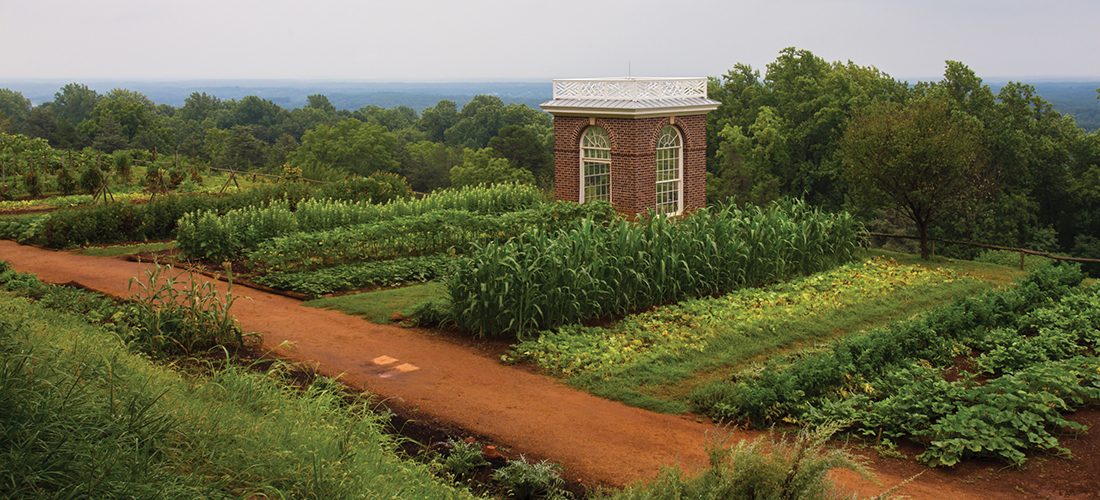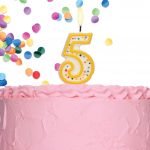
A patriotic anthem to gardeners, who are always young at heart
By Ross Howell Jr.
For several years I lived not far from Thomas Jefferson’s mountaintop estate, Monticello. I remember an archaeological dig under way on the mountain at the time.
Mulberry Row is an area that housed many of the plantation’s commercial activities in Jefferson’s day, as well as its enormous vegetable gardens. After meticulous excavation and research, the original buildings and gardens, including the Garden Pavilion overlooking the gardens and what Jefferson called his eastern “sea view,” were restored or recreated.
I liked visiting, seeing the progress. And the mountain was cooler, a relief from summer’s heat. It was wonderful to watch evening shadows lengthen across the lawn, the blues of the eastern view deepening as night came on.
Those memories are a reason the summer months put me in mind of Jefferson. And there’s the more obvious reason, of course — July Fourth. Of Jefferson’s many achievements, the Declaration of Independence was the one he most hoped his countrymen would remember him for.
And we do. We celebrate the words, “We hold these truths to be self-evident, that all men are created equal, that they are endowed by their Creator with certain unalienable Rights, that among these are Life, Liberty and the pursuit of Happiness,” with a national holiday, with cookouts, ice cream, parades, maybe a picnic at the ol’ swimming hole, and evening fireworks.
But this summer, now that the U.S. Social Security Administration has proclaimed with this birthday I am of “full retirement age,” I’m also mindful of something else Jefferson is remembered for.
His love of gardens.
On August 20, 1811, Jefferson penned a letter to his friend, Charles Willson Peale, the American painter admired for his portraits of the Founding Fathers, especially of George Washington. “I have often thought that if heaven had given me choice of my position & calling, it should have been on a rich spot of earth, well watered, and near a good market for the productions of the garden,” Jefferson wrote. “No occupation is so delightful to me as the culture of the earth . . . . But tho’ an old man, I am but a young gardener.”
Jefferson was just two years my elder at the time, so his words, along with the creaking of my knees as I weed a flower bed, serve as reminders that time is growing shorter, more precious.
Growing up on a mountain farm, I found work in my mother’s vegetable garden tedious. I much preferred working with our cattle and sheep. In spite of my mother’s passion, knowledge and skill, my interest in gardening didn’t come until later in life.
But Jefferson’s passion visited him as a young man and stayed.
In his “Garden Book” Jefferson kept records about the vegetables, flowers, fruits and trees he cultivated from 1766 to 1824 at Shadwell, his birthplace, and Monticello. He noted on February 20, 1767, that he “sowed a bed of forwardest and a bed of midling peas.”
The planting and harvesting of peas would be an enduring fascination for Jefferson. He participated in a competition with Monticello neighbors until very late in life̓ — whoever harvested the first pea of spring would host a celebratory dinner for the other competitors. Jefferson grew twenty-three varieties of peas at Monticello, notes Peter Hatch, the estate’s retired director of gardens and grounds. Maybe Jefferson was trying to load the odds in his favor.
While peas were a favorite, Hatch adds that Jefferson cultivated a wide variety of vegetables, including artichokes, asparagus and sea kale. Cucumbers were another favorite. He also grew “eggplants, sesame, hot peppers, okra, tomatoes, rutabagas, salsify and scores of other culinary novelties from the vegetable world,” Hatch writes.
According to Hatch, in 1769 Jefferson began planting fruit trees on the southeastern slope of the mountain, and in 1774, he began to plant Italian wine grapes provided by his neighbor and friend Philip Mazzei. He began, Hatch continues, with “extensive plantings of apple and peach trees in 1778 and 1782 in Monticello’s South Orchard, and the beginnings of vegetable-garden cultivation and the sowing of asparagus, peas and artichokes in prepared beds below Mulberry Row.”
Hatch writes that while serving as minister to France in 1786, Jefferson went on a tour of English landscape gardens with John Adams. The experience led him to introduce English features to Monticello, including the Grove, an 18-acre ornamental forest on the northwest side of the mountain. Its trees would be “trimmed very high, so as to give it the appearance of open ground,” Jefferson wrote, with the area “broken by clumps of thicket, as the open grounds of the English are broken by clumps of trees.”
Such a landscape feature would be relatively easy to create and economical to sustain, Jefferson felt, since it was only necessary to “to cut out the superabundant plants.” Aside from the beauty of the Grove, Jefferson pointed out a benefit we all look for in the summertime South. “Under the constant, beaming, almost vertical sun of Virginia,” he wrote, “shade is our Elysium.”
Jefferson felt that, over time, the mature Grove could be further refined with the introduction of vistas, glades and hardy perennial flowers. He even sketched a plan for thickets of shrubs arranged in a spiral pattern to suggest an informal labyrinth.
He was fascinated by native plants and their propagation, listing many in his Notes on the State of Virginia. He took delight in planting many of the specimens and seeds discovered on the Lewis and Clark Expedition (1804–1806).
Sometime after 1800, Jefferson wrote his “Summary of Public Service.” His purpose was to list achievements he considered notable, and to clarify some confusion about dates and legislation that had been attributed to him.
“I have sometimes asked myself whether my country is the better for my having lived at all?” he begins. Then he lists items that he viewed as beneficial. He includes items we would certainly expect: the Declaration of Independence, legislation regarding freedom of religion and an act in the Virginia legislature prohibiting the importation of slaves.
But Jefferson goes on to list other contributions that for most of us would be unexpected. He includes this notation: “In 1789. & 1790. I had a great number of olive plants of the best kind sent from Marseilles to Charleston for S. Carolina & Georgia. They were planted & are flourishing.” And another: “In 1790. I got a cask of the heavy upland rice from the river Denbigh in Africa. . . . which I sent to Charleston, in hopes it might supersede the culture of the wet rice which renders S. Carolina & Georgia so pestilential through the summer.” He concludes the rice entry by writing, “the greatest service which can be rendered any country is to add a useful plant to its culture.”
When you’re trying to think of a way to convince neighborhood rabbits to leave your peas alone, or attempting to unsnarl the Gordian knot on the head of your string trimmer, or watching your gladiolas droop in the heat, you probably aren’t feeling all that patriotic. You might be thinking only about getting a Jack Russell for the rabbits, or remembering to keep yourself hydrated.
But Jefferson, I believe, would want you to buck up. He would argue that you are a true patriot, the steward of a national legacy.
So this summer I want you to plant something.
Tree, shrub, vegetable, flower or seed, you’re going to have to nurture it. The task won’t be easy. Insects, voles, groundhogs and deer will conspire to defeat you. And an unforgiving sun. You’ll have to water and mulch your planting with care.
I’d even like you to make the planting a summertime tradition, a reminder of Independence Day. I’m doing it. By the time you read these words, I’ll have planted “Sweet Bubby,” a Carolina allspice bush, by my front porch, so my wife and I, along with friends, neighbors and guests, will enjoy its fragrance someday.
Of course, it would be much easier to plant successfully in the fall. But that’s the point.
Freedom and democracy are hard to maintain. They require passion, vigilance and perseverance. Like gardening.
In July 1826, Thomas Jefferson, 83 years old, had been lapsing in and out of consciousness at his mountaintop home for two days. His room had a view of his gardens, sweltering in the heat. From time to time, he would ask family members, “Is it the Fourth?” Not long after his grandson-in-law roused him in the morning with a touch on the shoulder to inform him Independence Day had come, Jefferson expired.
Far to the north, in Quincy, Massachusetts, 90-year-old John Adams, fellow patriot and signatory of the Declaration, lay clinging to life. From his bed he could hear the sounds of celebration for his nation’s fiftieth birthday. Though his friend had in fact passed away five hours earlier, Adams is said to have uttered with his last breath, “Thomas Jefferson still lives.”
After retiring from his second term as President, Jefferson wrote to a friend, “All my wishes end, where I hope my days will end, at Monticello.” That’s how his life ended, with a legacy to be studied by the ages, “in the midst of” his grandchildren, his books, his farm, his beloved gardens.
You don’t have to be an old man like me, or Jefferson, to plant this summer. But do it. You’ll see it’s a serious and uncertain endeavor.
Whatever you plant, do your level best to keep it alive. One day it may prosper. OH
Ross Howell Jr. is the author of the historical novel, Forsaken, and, in the interest of full disclosure, an alumnus of “Mr. Jefferson’s University.” His bride Mary Leigh, however, is a Chapel Hill alumna. Not long after the two were married, she took her husband to a basketball game in the Dean Dome, “just to make sure he had his head right.”





